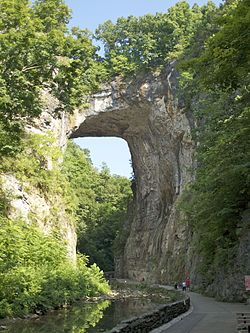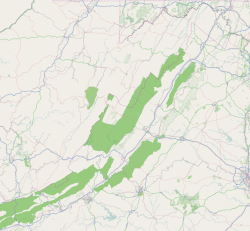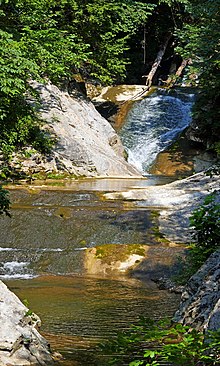United States historic place
| Natural Bridge | |
| U.S. National Register of Historic Places | |
| U.S. National Historic Landmark | |
 The Natural Bridge The Natural Bridge | |
   | |
| Nearest city | Natural Bridge, Virginia |
|---|---|
| Coordinates | 37°37′39″N 79°32′43″W / 37.62750°N 79.54528°W / 37.62750; -79.54528 |
| Part of | Natural Bridge Historic District (ID15001047) |
| NRHP reference No. | 97001401 |
| Significant dates | |
| Added to NRHP | November 18, 1997 |
| Designated NHL | August 6, 1998 |
Natural Bridge is a geological formation in Rockbridge County, Virginia, United States, comprising a 215-foot-high (66 m) natural arch with a span of 90 feet (27 m). It is situated within a gorge carved from the surrounding mountainous limestone terrain by Cedar Creek, a small tributary of the James River. Consisting of horizontal limestone strata, Natural Bridge is the remains of the roof of a cave or tunnel through which the Cedar Creek once flowed.
Natural Bridge has been designated a Virginia Historic Landmark and a National Historic Landmark. Since 2016, the bridge and its surroundings have been managed by the Commonwealth of Virginia as Natural Bridge State Park.
Geology
Rocks in the area are limestones and dolomites from the Ordovician Period, which implies deposition about 470 million years ago.
The carbonates of the Natural Bridge occur within the Chepultepec Formation, making the buttress of the bridge, and the Beekmantown Formation, deposited conformably over the Chepultepec and comprising the span and the upper part of the bridge. Strata at Natural Bridge are close to horizontal, in contrast with dipping and folded beds as close as 300 feet (91 m) away along Highway 11, which points to the fact that structurally the rocks making the Natural Bridge are the bottom part of a syncline.
The process of formation of the bridge is less certain, but the ideas proposed by different individuals have in common the importance of three elements: The southeast dipping of the strata, the capability of water to slowly dissolve carbonates, and the existence of numerous fractures. Edgar W. Spencer has provided a summary of the most respected interpretations and produced the presently most widely accepted hypothesis.
According to Spencer, the Natural Bridge was the remnant of an underground river tunnel that diverted water to the south. Initially, the underground river started capturing water from the Poague Run about two miles (3.2 km) to the north, contributing to enlarge the incipient Cedar Creek drainage basin. Over time, through weathering and erosion, the underground river collapsed and disappeared almost completely, the Natural Bridge being the only surviving relic of the roof of the ancient underground river. The creek's larger flow contributed to form the present-day gorge, significantly increasing the distance from the bottom of the water flow to the roof of the underground channel. Today, the "Lost River", about one-half mile (0.80 km) upstream from the Natural Bridge, is an example supporting the hypothesis of the underground river. Water from the side of the gorge flows into the Cedar Creek, similarly as the ancestral Cedar Creek underground river allegedly flowed into the Cascade Creek, presently entering the Cedar Creek approximately 500 feet (150 m) below the Natural Bridge.
Historic Rockbridge indicates that “Natural Bridge is part of the Beekmantown Formation from the Ordovician period, estimated to be 500 million years old.”
History

The Natural Bridge was a sacred site of the Native American Monacan tribe, who believed it to be the site of a major victory over pursuing Powhatans centuries before the arrival of Europeans in Virginia.
In March 1742, a frontiersman named John Howard — along with his son and others — was commissioned by Governor William Gooch to explore the southwest of Virginia as far as the Mississippi River. The party followed Cedar Creek through the Natural Bridge, then floated in buffalo-skin boats down the New, Coal, Kanawha, and Ohio rivers to the Mississippi.
It is alleged that George Washington also came to the site in 1750 as a young surveyor. To support claims that Washington surveyed the area, tour guides claim the initials "G.W." on the wall of the bridge, 23 feet (7.0 m) up, were carved by the future president. Legend also has it that George Washington threw a rock from the bottom of Cedar Creek over the bridge. In 1927, a large stone was found, also engraved "G.W." and bearing a surveyor's cross, which historians accepted as proof that he indeed surveyed the bridge.
Thomas Jefferson purchased 157 acres (64 ha) of land including the Natural Bridge from King George III of Great Britain for 20 shillings in 1774. He called it "the most Sublime of nature's works". Jefferson built a two-room log cabin, with one room reserved for guests, beginning its use as a retreat. While President, in 1802, he personally surveyed the area. Many famous guests stayed here, including John Marshall, James Monroe, Henry Clay, Sam Houston, and Martin Van Buren.

One of the earliest paintings of the Natural Bridge was done by Jacob Caleb Ward (1809–1891) in 1835. It is on view at the Nelson-Atkins Museum in Kansas City, Missouri.
Natural Bridge was one of the tourist attractions of the new world that Europeans visited during the 18th and 19th centuries. Vacationing guests from all over the world took day trips from Natural Bridge on horseback or horse-drawn carriages to explore the countryside. In 1833, a new owner erected the Forest Inn to accommodate the increasing number of people.
The bridge had considerable notoriety during the 19th century. Herman Melville alluded to the bridge in describing Moby-Dick: "But soon the fore part of him slowly rose from the water; for an instant his whole marbleized body formed a high arch, like Virginia's Natural Bridge..." William Cullen Bryant, another American literary figure, said that Natural Bridge and Niagara Falls were the two most remarkable features of North America. During the 1880s Natural Bridge was a resort owned by Colonel Henry Parsons, who also owned the nearby Rockbridge Inn.
In 1927 a nocturnal lighting display of the arch and gorge was designed by Samuel Hibben and Phinehas V. Stephens, illuminating engineers with the Westinghouse Company. The display was formally switched on by President Calvin Coolidge in a 1927 inaugural ceremony. The original display has since been replaced with a sound and light show depicting the biblical seven days of the Creation as described in Genesis.
In 2013, nearly 1,500 acres (6.1 km), including the bridge, were slated to be sold at auction. To prevent piecemeal development of the landmark, the Virginia Conservation Legacy Fund (VCLF) purchased the bridge, hotel, and surrounding land for $9.1 million, made possible by a loan from the Virginia Clean Water Revolving Loan Fund. When the VCLF soon found itself unable to make payments on that loan, the Commonwealth of Virginia offered to manage the property as a Virginia State Park.
Natural Bridge State Park

Natural Bridge State Park officially opened on September 24, 2016. As a state park, the property is owned and managed by the Virginia Department of Conservation and Recreation.
Visitors must purchase tickets to view the bridge from below, although the park's fees under state management are about half what had been charged under prior ownership. U.S. Route 11 (Lee Highway) runs on top of the bridge, but protective fences make it difficult to see anything besides the roadway.
The state park includes several long-standing attractions, including the trail under the bridge, along Cedar Creek and the 30-foot-tall (9.1 m) Lace Falls. One change under state ownership was the removal of Foamhenge, a full-size replica of Stonehenge made entirely out of styrofoam that was formerly located on the property. The attraction was moved to Fairfax County after it was determined that the art installation did not fit with the state park's mission.
The new state park was designated an "Affiliated Area" by the National Park Service in 2016. The designation does not imply ownership or management by the federal government, though it does allow for their technical and financial assistance.
See also
- List of bridges on the National Register of Historic Places in Virginia
- List of National Historic Landmarks in Virginia
- List of Virginia state parks
- National Register of Historic Places listings in Rockbridge County, Virginia
References
- "National Register Information System". National Register of Historic Places. National Park Service. April 15, 2008.
- "Natural Bridge". National Historic Landmark summary listing. National Park Service. Archived from the original on October 10, 2012. Retrieved June 27, 2008.
- ^ "Natural Bridge State Park - General Information". Virginia Department of Conservation and Recreation. Retrieved January 1, 2017.
- Spencer, Edgard W. (1968). "Geology of the Natural Bridge, Sugarloaf Mountain, Buchanan, and Arnold Valley quadrangles, Virginia: Report of Investigations 13" (PDF). Virginia Division of Mineral Resources. Charlottesville, Virginia.
- Spencer, Edgard W. (1964). "Natural Bridge and vicinity". Virginia Minerals. 10 (2): 1−6.
- Philbrick, Hope S. "Virginia's Natural Bridge – An Awe-Inspiring Wonder". Lexington, The Historic Rockbridge Area. Retrieved March 5, 2023.
- ^ Willis. Carrie Hunter; Walker, Etta Belle (1937). "Natural Bridge". Legends of the Skyline Drive and the Great Valley of Virginia. pp. 81–83.
- Brown, Jr., Stuart E. (1965), Virginia Baron: The Story of Thomas 6th Lord Fairfax, Berryville, Virginia: Chesapeake Book Company, pp 98-99.
- "Natural Bridge, Virginia".
- Melville, Herman (1892) . Moby Dick. Boston: St. Botolph Society. p. 508.
- Bryant, William Cullen (1894). Picturesque America: Or, The Land We Live In. A Delineation by Pen and Pencil of the Mountains, Rivers, Lakes, Water-falls, Shores, Cañons, Valleys, Cities, and Other Picturesque Features of Our Country. D. Appleton. p. 41. Retrieved February 13, 2017.
- Dianne and Joseph Pierce (July 1994). "National Register of Historic Places Inventory/Nomination: Rockbridge Inn" (PDF). Virginia Department of Historic Resources.
- Hibben, Samuel G. and Stephens, Phinehas V. The illumination of the Natural Bridge of Virginia, Transactions of the Illuminating Engineering Society, vol. 22, 1927, 1158-1164.
- ^ Hammack, Laurence (September 24, 2016). "Rockbridge County's famous landmark becomes Natural Bridge State Park". The Roanoke Times. Retrieved January 1, 2017.
- ^ Lucas, Rachel (September 24, 2016). "Natural Bridge officially becomes a state park, affiliated with National Park Service". WSLS.com. Retrieved January 1, 2017.
- Lohmann, Bill (August 29, 2016). "Foamhenge finds new home at Cox Farms in Fairfax County". Richmond Times-Dispatch. Retrieved January 1, 2017.
- "Designations of National Park System Units". U.S. National Park Service. Retrieved January 2, 2017.
External links
- Natural Bridge State Park official website
- Natural Bridge Hotel website
- Video showing various places at the site from 2016
- Natural Bridge Bed and Breakfast Lodging
| U.S. National Register of Historic Places | |
|---|---|
| Topics | |
| Lists by state |
|
| Lists by insular areas | |
| Lists by associated state | |
| Other areas | |
| Related | |
- James River (Virginia)
- National Historic Landmarks in Virginia
- Natural arches of Virginia
- Landforms of Rockbridge County, Virginia
- Religious places of the Indigenous peoples of North America
- Tourist attractions in Rockbridge County, Virginia
- Protected areas of Rockbridge County, Virginia
- U.S. Route 11
- National Register of Historic Places in Rockbridge County, Virginia
- Caves of Virginia
- Virginia Historic Landmarks
- Bridges of the United States Numbered Highway System
- State parks of Virginia